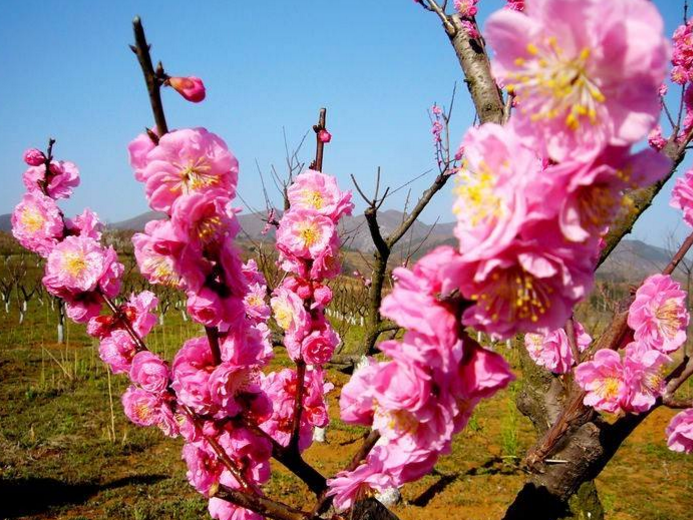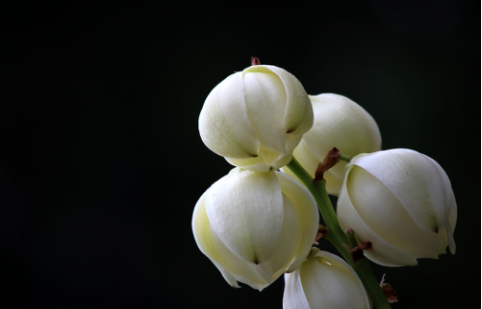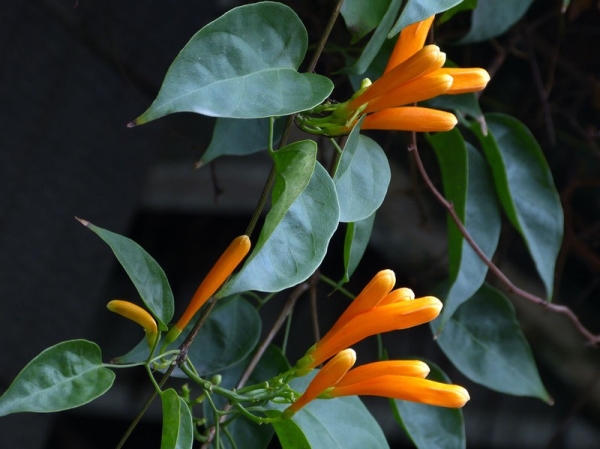The planting method of plum blossom
First, planting in the ground
1. Selection of environmental seedlings.
Should choose the sunny, deep and fertile soil, loose topsoil, slightly heavy clay planting, where the plant growth is better. It is easy to survive when planted with bare roots of 1-year-old and 2-year-old seedlings in spring, and large plum blossom seedlings of more than 3 years must be planted with soil balls.

2. Fertilization
The base fertilizer was applied at the bottom of the hole, and then watered once after planting, so that the root system was closely combined with the soil. Plum blossoms can be planted alone, opposite or in groups, or scattered among pine forests and bamboo bushes. Plum blossom likes fertilizer, digging trenches and fertilizing in the crown projection circle every winter, and then applying nitrogen-based fertilizer after blossom to promote the growth of branches.
The plant began to transfer to the stage of reproductive growth in June. The period from June to August is the period of flower bud differentiation of plum blossoms, and the nutritional status of trees has a great influence on flower bud differentiation. At this time, topdressing based on phosphorus and potassium should be applied to ensure the smooth progress of flower bud differentiation. Plum blossom avoid wet water, should pay attention to drainage when it is rainy in summer, such as the root system is easy to rot when the soil is too wet.
3. Shaping and pruning
Pruning is an important measure to promote plum blossom and maintain tree shape. Because the plum blossom forms flower buds on the annual branches picked in spring and blossoms in the next spring, the branches are cut lightly and short within a week after flowering every year to promote more lateral branches to blossom more in the second year. The tree shape of plum blossom is sparse for beauty, not too much emphasis on the direction and distance of branches, should be pruned into a natural happy shape, branches evenly distributed, slightly sparse as well. Cut off the disease and insect branches, withered branches, weak branches, overgrown branches, cross branches and dense branches in winter to make the crown ventilated and transparent. Plum blossom pruning should be light, overweight will lead to overgrowth, affecting the flowering of the second year.
2. Potted planting methods
1. Select seedlings and put them on the pot
During the dormant period, the 1-and 2-year-old plum seedlings planted in the open field should be planted in the pot. the basin soil should be fertile and loose, and the bottom of the basin should be fertilized with base fertilizer. According to experience, plum seedlings should not be irrigated with clear water, but should be filled with rotten and filtered thick fecal water to make the soil wet through the basin, which can promote the plum plant to grow well. Flowerpots should be cultivated in a ventilated and sunny place, and the distance between pots should be based on the non-shade of the canopy, which is not only ventilated and transparent, but also conducive to operation.
2. Watering
Watering potted plum is the key, neither too wet nor too dry. Defoliation is often caused by improper watering in summer. Plum blossom is afraid of waterlogging, when it rains heavily, the side basin should be poured, and the sky will clear up after the rain, so it should be corrected in time. After entering autumn, the amount of water is reduced, once every other day. In order to promote the flower bud differentiation of plum blossom from June to August, the method of "buckling water" is usually used to control plant vegetative growth and promote flower bud differentiation. When the branches grow 20cm or so at the beginning of June, they are not watered normally, and when the leaves on the branches wilt and sag, they are watered again and again, and repeated several times, by reducing the amount of water combined with coring and twisting, the growth of branches is inhibited or stopped, so that nutrients can be concentrated to supply flower bud differentiation, and the quantity of flower bud differentiation is of good quality.
3. Fertilization
Potted plum blossom fertilization is very important, not only can not be caused by overgrowth, but also to ensure the need for growth and flowering. In addition to base fertilizer, topdressing was applied twice before June to ensure that the nutrients needed for the growth of branches and leaves were met. Controlling nitrogen fertilizer and applying phosphorus and potassium fertilizer twice at the beginning of June were beneficial to flower bud differentiation, flower color maintenance and flowering. Fertilizer should be stopped at the height of summer. From bud expansion to flowering, proper fertilization and watering should be applied during this period to ensure the supply of water. In full bloom, less watering, slightly dry, can prolong the flowering period.
III. Propagation methods of plum blossoms
Multi-use grafting method, followed by cutting method, striping method, the least use is sowing method.
1. Grafting propagation
Splicing or digging is used from February to March in spring. It is easy to survive by bud grafting in autumn. The rootstock uses 1-2-year-old mountain peach, hairy peach, apricot or real plum. Using apricot and plum as rootstocks, the grafted seedlings grew slowly in the early stage, but they had a long life and less diseases and insect pests. The scion was cut after defoliation, stored at 0: 5 ℃, and picked as it was grafted in spring, which was beneficial to survival. In order to make the old plum pile in Suzhou and Yangzhou, the old plum pile was propagated by grafting. The specific method was to graft the variety plum on the old root of fruit plum, which was carried out from June to August.
2. Sowing and reproduction
Seedlings bloom for 3 ~ 4 years, but they are easy to degenerate, so they are only used as rootstocks or when cultivating new varieties. In May, plums ripen and turn yellow. the fruit is picked and rubbed to remove pulp, put in a ventilated place and dried in the shade, and stored in wet sand. It usually sows in autumn. The row spacing is 25 ~ 30cm and the plant spacing is 5~10cm. After sowing, covered with soil 2~3cm, covered with grass to protect moisture and cold, germinated in the next spring, managed for 1 ~ 2 years, stem diameter 1~2cm, can be used as rootstock.
3. Cuttage propagation
Plum blossom should use tender branch spray cutting method, the survival rate of most varieties can reach about 60%, but some varieties are not easy to survive. According to the experience of Wuhan Botanical Garden, the cutting survival rate of plum blossom is not only related to variety, but also related to tree age, branch location and robust degree. The survival rate of green calyx and palace powder was higher. The cutting time of plum blossom is better in November. The cuttings were taken from the periphery of the tree crown with one-year-old branches. The branches of young trees can be used as long as they are stout, full and free from diseases and insect pests. Cut the branches into 10~15cm, soak them with naphthylacetic acid 1000~2000mg/kg for a few seconds, cut them in loose soil, expose only one top bud, spray water once after planting, and often keep the soil moist after planting. Because plum blossom is afraid of dampness, it is not suitable to use water to cut after bed, nor should it be irrigated by flood after cutting, otherwise the bed soil is too wet, causing mildew and rot. In order to keep wet and warm, the cuttings are sealed in a plastic shed. The plum blossom cuttings healed in the same year and took root in the next spring.
4. Pressing strip
From February to March, the sturdy 1 ~ 3-year growing branches were selected, and a trench was dug next to the mother plant. At the bottom of the bend of the branches, the bark was shallowly carved 2 or 3 wounds with a knife, then buried in the soil, and the branched branches were inserted into the buried strips to fix the strips and prevent them from bouncing up. After rooting, it was cut off from the mother and planted. When large seedlings need to be propagated, high pressure is used to select stout branches on the mother tree in the plum rain season, cut or cut around the pressing part, loosen the soil with plastic sheet, tie tightly at both ends, maintain humidity, cut off and plant after rooting.
Pest control of plum blossom
Plum blossom is easy to suffer from powdery mildew and soot, so it should be prevented as soon as possible so as not to cause early defoliation. The common pests are aphids, red spiders, leaf rollers and so on. In addition, plum blossom in poor drainage, prone to root rot, light will be dug out of the plant exposure, replanting, serious can try to use root sterilization and antiseptic treatment.
Friends who like plum blossoms should raise a pot as soon as possible. For more information about plum blossoms, please follow the four Seasons Plant Network!
The planting method of plum blossom
Flower Bonsai net Flower maintenance column: the planting method of plum blossom will introduce you to the cultivation method of plum blossom, how good plum blossom is, and the prevention and control of diseases and insect pests of plum blossom.
Plum blossom belongs to Rosaceae trees and flowers.
[ornamental value of plum blossoms] the first leaves of the flowers are open, with fragrance, there are more than a hundred varieties, and the colors are white, pink, red and purple, which are the traditional famous flowers in China. Flowering 1 ~ 2 months, Ye Xiuzhi beautiful, simple and elegant, often used as a potted pile landscape.
[plum blossom habits] (1) good sunshine, if kept in the shade for a long time, there will be few flowers. (2) suitable for warm and humid, frost injury below-18 ℃. Sensitive to air pollution and poor growth in urban environment. (3) Sandy loam with good drainage and like dampness and fear of waterlogging. [main points of plum blossom cultivation] (1) improved varieties are used for propagation to graft Mao peach rootstocks. (2) 6 ~ 7 parts of garden soil for basin soil were mixed with 3 ~ 4 parts of carbon ash. (3) the basin soil should be dry-poured and wet-stopped after germination. Watering of flower buds should be postponed in early summer. The soil should be kept moist and not too dry in summer and autumn. If the leaves are not too dry, they do not need to be watered. In the middle of winter and early spring, it should be slightly wetter than after falling leaves. In short, the pot soil should not be too wet, otherwise it is easy to rot the roots. (4) No fertilizer should be applied after defoliation, once fertilizer should be applied after flowering, and one proper topdressing should be applied from late August to September. Fertilizer can be used with rotten oil, dry water or human feces and urine. (5) pruning in winter or after flowering, pruning and pruning young trees to keep their length properly to promote the emergence of more branches. The old tree should be re-pruned properly, and the length and direction of the branches should be considered to be graceful (see Q & A 69-70 for details). (6) potted flowers should be placed in the sunny place in spring, summer and autumn to facilitate ventilation and light to reduce diseases and insect pests.
How do you grow plum blossoms? The planting method of plum blossom
If the plum blossom wants to be planted well, the planting method is the key. Then the editor will introduce the planting method of plum blossom to you in detail to help you better plant plum blossom.
The method of planting plum blossoms:
1. Use soil
It is appropriate to choose sandy loam with good drainage and permeability. This kind of culture soil can be made of peat, fine sand and garden soil according to the proportion of 1:1, and if possible, it is better to put a small amount of rotten leaf soil into it. The purpose of adding rotten leaf soil is to improve the fertilizer storage capacity of the culture and make the culture soil show a slightly acidic reaction.
2. Selection of basin
Mei Jun Poya can set off each other and add ornamental value. However, it is best to plant the plum blossom in an ordinary tile pot, and then cover it with an elegant flowerpot when the plant blossoms. Because the tile basin is conducive to the root growth of plum blossoms, while the antique porcelain basin or purple sand basin is slightly inferior.
3. Watering
In winter and spring, plum blossoms do not need much water. Except for making the potted soil slightly moist during the flowering period, the other stages keep the potted soil slightly dry. Summer and autumn, is the plum blossom needs the most water stage, should see dry watering. However, from June to July, the flower buds begin to differentiate, and it is necessary to "control the water" of plum blossoms several times, that is, to reduce watering so that plum blossom leaves are rewatered, so that plum blossoms can blossom better.
4. Fertilization
Plum blossoms like fertilizer, but the supply of fertilizer should be timely and appropriate, and dilute liquid fertilizer can be applied every 10 days from the end of spring to the beginning of summer. From late winter to early spring, when plum blossom buds begin to grow to transparent color, thin liquid fertilizer should be applied every 5 days to make plum blossom blossom colorful and fragrant.
5. Lighting
The location is sunny, the plum blossom grows healthily and has more flowers, on the contrary, the plant grows slowly and the flower bud differentiation is less. Therefore, it is necessary to ensure that potted plum blossoms receive 4 to 6 hours of sunlight every day. During the flowering period of plum blossoms, especially after their flower buds begin to expand, receiving hours of direct sunlight every day is conducive to flowering. When the plum blossom blossoms, it should be placed in a bright place without direct sunlight, otherwise the flowers will soon fade away.
6. Pruning
Annual pruning is essential if plum blossoms are to have a beautiful tree shape and strong growth. Plum blossom in the vigorous growth season to pick the heart of the branch, so that it can only grow to a height of 20ml / m / 30cm. At the same time, the sprouts on the rootstocks should be cut off at any time, and the weak branches and internal branches should be cut off in time. In addition, the sprouts on the rootstocks should be removed at any time. When the plum blossom is in blossom, it should also be pruned, leaving only 3 to 5 buds at the base of each branch. Spring branch sprouting should also be carried out to make rational distribution of nutrients, so that plum blossoms can grow more beautiful and strong.
- Prev

Prevention and Control of Diseases and insect pests of Yucca
Yucca has fewer diseases and insect pests, but it is also necessary to do a good job in prevention and control. The common pests are shell insects, whitefly and coir moth, which can be controlled by corresponding drugs. The common diseases are brown spot and leaf spot, which can be controlled by spraying with corresponding powder.
- Next

Propagation method of firecracker flower
The most common method of cutting propagation is cutting propagation. The cuttage propagation of firecracker flowers is generally chosen in spring, because the survival rate of propagation is higher during this period. First of all, we should choose the right cuttings, cut the mature stems of firecrackers, and choose sturdy branches free from diseases and insect pests.
Related
- Fuxing push coffee new agricultural production and marketing class: lack of small-scale processing plants
- Jujube rice field leisure farm deep ploughing Yilan for five years to create a space for organic food and play
- Nongyu Farm-A trial of organic papaya for brave women with advanced technology
- Four points for attention in the prevention and control of diseases and insect pests of edible fungi
- How to add nutrient solution to Edible Fungi
- Is there any good way to control edible fungus mites?
- Open Inoculation Technology of Edible Fungi
- Is there any clever way to use fertilizer for edible fungus in winter?
- What agents are used to kill the pathogens of edible fungi in the mushroom shed?
- Rapid drying of Edible Fungi

